Other Features
Most articles in this section were originally written for websites belonging to organizations affiliated with NASA/GISS or NASA/GSFC. The articles describe research that to some extent involves GISS science activities.
2020

The Drying U.S. West.
A serious drought has flared up across half of the United States — a familiar story for the past two decades.
(2020-12-14)
+ Read Feature

A Devastating Abundance
The 2020 Atlantic hurricane season was supercharged, and not just in raw numbers.
(2020-12-10)
+ Read Feature

Making Sense of "Climate Sensitivity"
GISS scientists answer questions about a new study that narrows the range of uncertainty in future climate projections.
(2020-09-09)
+ Read Feature

NASA Scientists Explore Venus Habitable Climate Scenarios at NCCS
GISS scientists leveraged NASA supercomputing resources for several months to model a hypothetical climate history for Venus over the past 4.2 billion years.
(2020-08-28)
+ Read Feature

Another Intense Summer of Fires in Siberia
Following an active 2019 season, fires in 2020 have again been abundant, widespread, and have produced abnormally large carbon emissions.
(2020-08-07)
+ Read Feature

Gearing Up for an Active 2020 Hurricane Season
Abnormally warm ocean temperatures and a potential La Niña set the stage for an above-average Atlantic hurricane season.
(2020-07-20)
+ Read Feature

Heat and Fire Scorches Siberia
Fires are raging in eastern Siberia in the midst of an unusually long-lived heat wave.
(2020-06-24)
+ Read Feature

Simulations Probe Sun's Effects on Climate
A series of model studies analyzed the effect of the solar cycle and varying solar conditions at all wavelengths.
(2020-06-16)
+ Read Feature

A Fiery Month in Zulia
After dry weather parched the soil and vegetation, large fires burned in the northwestern Venezuela state.
(2020-04-29)
+ Read Feature

NASA Simulations Explore Habitability of Nearest Exoplanet
Powered by the Discover supercomputer, climate simulations incorporated a dynamic ocean to explore the habitability of Proxima Centauri b.
(2020-02-21)
+ Read Feature

Growth of a Summer Storm
Afternoon thunderstorms are a typical phenomenon during summer in Western Australia.
(2020-01-17)
+ Read Feature
2019

Smoke Blankets Borneo
Fires burning in peat deposits in Indonesia release gases and particles with consequences for public health and the climate.
(2019-09-17)
+ Read Feature

Scientists Simulate Ancient Lunar Atmosphere at NCCS
Using NASA Center for Climate Simulation computing resources, exoplanet modelers simulated a thin, relatively short-lived atmosphere.
(2019-09-13)
+ Read Feature

A Devastating Stall by Hurricane Dorian
A remarkable slowdown by the hurricane led to a prolonged lashing from winds, waves, and rain that devastated Grand Bahama Island.
(2019-09-09)
+ Read Feature
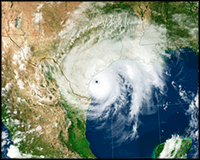
Tropical Cyclones are Stalling More
Storms in the North Atlantic are lingering longer near the coast, leading to significantly more rainfall.
(2019-06-06)
+ Read Feature

Choking on Saharan Dust
A new analysis suggests that exposure to mineral dust may be a bigger cause of premature death in Africa than previously thought.
(2019-05-01)
+ Read Feature

ModelE Simulations Assess Impacts of Irrigation on Climate
Researchers used NCCS supercomputing resources to identify and understand the interactions between simple land-cover change and more complex land-management, including irrigation.
(2019-04-22)
+ Read Feature

Wallace Broecker and GISS
GISS scientists remember friend, mentor, research collaborator, and sometimes foil Wally Broecker of the Columbia Lamont-Doherty Earth Observatory.
(2019-03-18)
+ Read Feature
2018
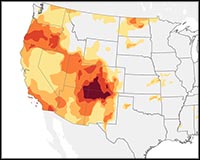
Drought Persists in the U.S. Southwest
Persistent drought conditions have spread across the U.S. Southwest, with the Four Corners area standing out as extremely dry.
(2018-11-08)
+ Read Feature

The New UN Climate Report in One Sentence
The essence of the recent UN/IPCC report about the planetary disruption resulting from the carbon that human activity puts into the atmosphere can be summed up in a single sentence.
(2018-10-19)
+ Read Feature

Foreacting Fire
The Global Fire Weather Database accounts for local winds, temperatures, and humidity, while also being the first fire prediction model to include satellite–based precipitation measurements.
(2018-07-03)
+ Read Feature
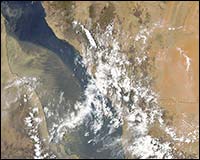
Waves of Dust Over the Red Sea
Recent satellite imagery showed waves in the dust clouds blown from the Sahara Desert over the Red Sea.
(2018-06-15)
+ Read Feature
2017

Curvy Contrails
Viewing satellite imagery of clouds sometimes reveals curiosities in the sky.
(2017-12-20)
+ Read Feature

Increasing Resiliency to Extreme Weather
The 2017 hurricane season could be the turning point in planning for climate resilience. NASA scientists provide risk information for preparatory action.
(2017-11-06)
+ Read Feature
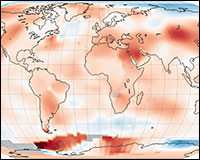
Another Hot July
July 2017 was statistically tied with July 2016 as the warmest July in the 137 years of modern record-keeping.
(2017-08-22)
+ Read Feature
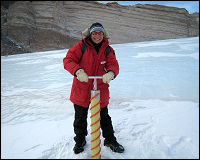
Core Questions: An Introduction to Ice Cores
How drilling deeply can help to understand climates of the past and predict climates of the future.
(2017-08-15)
+ Read Feature
2016
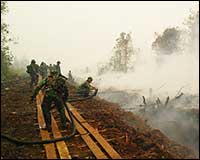
El Niño a Key Player in Severe Indonesia Fires
In some locations, changes in ocean temperatures and atmospheric patterns brought about by El Niño lead to drier conditions, which increases the damage during "fire season".
(2016-09-09)
+ Read Feature

Extreme Heat for an Extreme Year
In the summer of 2016, extreme heat waves gripped Siberia, the Middle East, and North America.
(2016-08-11)
+ Read Feature

Cloud-Gazing: Gravity Waves off the Coast of Africa
Interaction of dry air off the Namibian desert with moist over the ocean forms clouds that rise and fall due to gravity, forming wave patterns.
(2016-07-14)
+ Read Feature

Farms Act as Major Source of Air Pollution
New study shows that emissions from farms outweigh all other human sources of fine-particulate air pollution in much of the United States, Europe, Russia and China.
(2016-05-16)
+ Read Feature

Heat Fuels Fire at Fort McMurray
In early May 2016, a destructive wildfire burned through Canada’s Fort McMurray in the Northern Alberta region. Windy, dry, and unseasonably hot conditions all set the stage for the fire.
(2016-05-07)
+ Read Feature

Record Warmth in February
Almost all land surfaces on the planet experienced unusually warm temperatures during the month of February 2016, making it the warmest February in 136 years of modern temperature records.
(2016-03-17)
+ Read Feature
2015

Seeing Through the Smoky Pall: Indonesias's Fire Season
Thick peat, El Niño weather, and economic development in Indonesia came together to produce prodigious fires and planet-warming emissions. Scientists used many tools to better understand why the fires were so severe and what their impact was on human health and the environment.
(2015-12-01)
+ Read Feature

Declining Snowpacks May Cut Many Nations' Water
Snow is an important seasonal water source around large mountain chains. A new study has examined the potential effects of declining snow accumulations in many regions around the world, identifying areas that may be particularly vulnerable.
(2015-11-12)
+ Read Feature

Smoke Blankets Indonesia
Fires in Indonesia are persistent, difficult to extinguish, and very polluting. Climatologists worry that this year could be very bad as a strong El Niño influences reduces regional rainfall.
(2015-09-27)
+ Read Feature

Sea Level Rise Hits Home at NASA
Sea level rise hits especially close to home for NASA because half to two-thirds of agency infrastructure and
assets stand within 16 feet of sea level.
(2015-08-26)
+ Read Feature

"Snowball Earth" Might Have Been Slushy
GISS climate modelers go back in time to simulate past "Snowball Earth" conditions of 720 to 635 million years ago and find that complete freeze-over is hard to achieve.
(2015-08-04)
+ Read Feature

NASA's Exoplanet Nexus — 2. Looking to the Stars
While NASA GISS was opening the eyes of the world to new areas of Earth systems science, its research roots in planetary science continued. That expertise will now be applied to exoplanet systems science.
(2015-04-23)
+ Read Research Feature

NASA's Exoplanet Nexus — 1. A History in Climate Studies
NASA GISS is providing atmosphere and climate expertise to the Nexus for Exoplanet System Science. GISS has been a key player in the study of planetary climates and atmospheres for decades.
(2015-04-21)
+ Read Research Feature

Why So Many Global Temperature Records?
You could hardly miss the media stories about how the past year ranked in terms of global temperatures. Astute readers may ask: how do different institutions come up with slightly different numbers for the same planet?
(2015-01-21)
+ Read Feature
2014

Rising Temperatures: A Month Versus a Decade
You may have heard that September 2014 was the warmest on record.
But how meaningful is it when you hear that a recent month or season broke temperature records?
(2014-10-23)
+ Read Feature

Climate Conditions Help Forecast Meningitis Outbreaks
Meningitis incidence in sub-Saharan Africa is linked to wind and dust conditions as predictors of the disease.
(2014-03-17)
+ Read Feature

An Ecosystem Feels the Human Touch
A study compares the extent of human impact on a Hudson River ecosystem to those felt during historic periods of climate change.
(2014-02-18)
+ Read Feature
2013

The Full Palette of Photosynthesis
Researchers are collecting data on photosynthetic pigments from Earth to help imagine the possible colors of life on other planets.
(2013-11-01)
+ Read Feature

In a Warming World, the Storms May Be Fewer But Stronger
Extreme storms prompt questions about whether climate change is affecting weather intensity. Satellites, statistics, and models are teaching us a lot about what we know and do not know about such storms.
(2013-03-15)
+ Read Feature
2012

Storms in the Machine
To estimate the odds of a major typhoon striking a coastal region and how climate change may shift those odds, a statistical model examines how the El Niño cycle affects storm generation and behavior.
(2012-11-21)
+ Read Feature

Fresh Air for the Future
A study of tropospheric ozone and black carbon, pollutants from human activities which disrupt Earth's climate, shows that emission control measures could prevent millions of premature deaths by the year 2030.
(2012-10-10)
+ Read Feature

Far-Out Photosynthesis
As we search for habitable planets in other solar systems, how similar can we expect the optical signs of photosynthesis to be those of Earth?
(Feb '12)
+ Read Feature
2010

From Ash in the Wind to Smoke from the Stack
Aerosols don't just come from spray cans. Any airborne particle or droplet, whether from a canister, the smokestack of a factory, or a dust storm, is an aerosol.
(Apr '10)
+ Read Feature

Cold Snaps Plus Global Warming Do Add Up
Even as the globally averaged temperature trends upward, extended periods of regionally cool weather and even historic snowfalls can still occur.
(Feb '10)
+ Read Feature
2009

Catalog of Change
From declining fish catches in African lakes to shortened hibernation of North American mammals, climate change is having observable impacts around the world.
(Nov '09)
+ Read Feature

Think Global, Act Local
A study that examined how pollution causes variations in how much solar radiation reaches Earth's surface used both local and satellite data.
(Nov '09)
+ Read Feature

Linking Climate and Habitability
Scientists are now learning how small shifts in climate can have dramatic consequences for the planet's environment and the life that depends on it.
(Jun '09)
+ Read Feature
2007
Earth's Temperature Tracker
After tracking Earth temperature for decades, NASA scientist James Hansen is confident the global warming trend observed since 1880 is mainly the result of human-produced greenhouse gases.
(Nov '07)
+ Read Feature
2006

Study the Past, Predict the Future
Scientists use the theories they have constructed to explain the paleoclimate data record to understand modern climate and to predict how we can expect it to change in coming years or decades.
(Nov '06)
+ Read Feature
2004

Methane: Climate Super-Star
In 30 years, our knowledge of methane has traveled from obscure trace gas to important greenhouse forcing, both natural and anthropogenic. What caused this change, and what role has methane played in climate, both in the past and future.
(Sep. '04)
+ Read Feature

Atmospheric Tango
Ozone affects climate, and climate affects ozone. Temperature, humidity, winds, and the presence of other chemicals in the atmosphere influence ozone formation, and the presence of ozone, in turn, affects those atmospheric constituents.
(Feb. '04)
+ Read Feature
2001
Nov. 2001: Global Warming in the 21st Century: An Alternative Scenario
May 2001: Forcing Agents Underlying Climate Change
1997
Aug. 1997: Clouds in Midlatitude Storms
Apr. 1997: The Climate of the Pliocene: Simulating Earth's Last Great Warm Period

